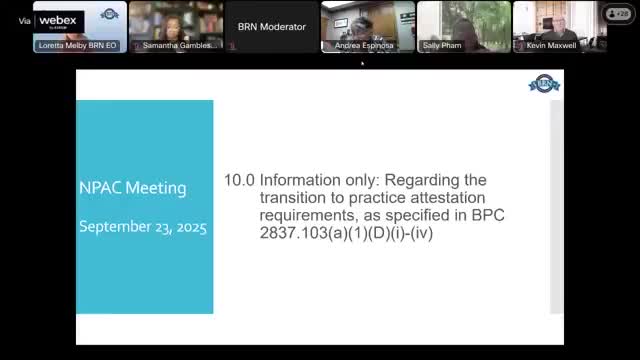Board explains new transition-to-practice attestation: hours-only verification, liability shield for attestors
September 30, 2025 | California Board of Registered Nursing, Boards and Commissions, Executive, California
This article was created by AI summarizing key points discussed. AI makes mistakes, so for full details and context, please refer to the video of the full meeting. Please report any errors so we can fix them. Report an error »

Board of Registered Nursing staff briefed the Nurse Practitioner Advisory Committee on Sept. 24 about new statutory requirements for transition-to-practice attestations that accompany certification for advanced practice nurse categories known in the discussion as “103” and “104.” The board said the law allows an attester — a licensed physician or a 103/104 certified nurse practitioner — to “only attest to the completion of the transition to practice” and not to verify clinical competence.
Executive Officer Loretta Melby displayed the statutory language and explained the practical effects: applicants may meet the transition-to-practice requirement by documenting a minimum of three full-time equivalent years of practice or 4,600 hours in direct patient care within the prior five years, and that proof can be provided on a board-prescribed attestation form. Melby read aloud the statute that “a licensed physician and surgeon or certified nurse practitioner…is not required to verify competence” and noted the law also shields attestors from civil, criminal, administrative, disciplinary, employment, credentialing and other liability for providing or refusing an attestation, except where an attestation is produced fraudulently.
Committee members raised concerns about the loosened attestation standard. Public member Betha Schnell and committee members questioned whether the absence of a competence verification could create opportunities for weak or transactional attestations. Schnell said she found the “very, very loose language and criteria” concerning from a consumer-protection perspective and asked whether the board could take further steps to verify competence or set standards.
Board staff responded that the statutory language supersedes prior regulations and limits the board’s options. Melby said the BRN can investigate and act if an attestation is fraudulent, but it cannot require attestors to make competence judgments that the statute removes. Staff noted the board previously tried to define transition-to-practice elements by regulation, but the legislative changes replaced those regulatory limitations.
Committee members asked operational questions the board could not resolve at the meeting, including who may sign attestations, whether telehealth or out-of-area attestations are valid, and how referral plans should be documented. Melby said attestations may be provided by physicians or by certified NPs and that there is no statutory geographic limitation; telehealth arrangements could factor into practice models but do not alter the statutory attestation rules.
Committee members agreed to continue the conversation in subcommittee and to bring examples, implementation questions and interstate comparisons to future meetings. Staff said the board will publish implementation guidance once bill language is chaptered and the BRN completes its internal implementation planning.
Executive Officer Loretta Melby displayed the statutory language and explained the practical effects: applicants may meet the transition-to-practice requirement by documenting a minimum of three full-time equivalent years of practice or 4,600 hours in direct patient care within the prior five years, and that proof can be provided on a board-prescribed attestation form. Melby read aloud the statute that “a licensed physician and surgeon or certified nurse practitioner…is not required to verify competence” and noted the law also shields attestors from civil, criminal, administrative, disciplinary, employment, credentialing and other liability for providing or refusing an attestation, except where an attestation is produced fraudulently.
Committee members raised concerns about the loosened attestation standard. Public member Betha Schnell and committee members questioned whether the absence of a competence verification could create opportunities for weak or transactional attestations. Schnell said she found the “very, very loose language and criteria” concerning from a consumer-protection perspective and asked whether the board could take further steps to verify competence or set standards.
Board staff responded that the statutory language supersedes prior regulations and limits the board’s options. Melby said the BRN can investigate and act if an attestation is fraudulent, but it cannot require attestors to make competence judgments that the statute removes. Staff noted the board previously tried to define transition-to-practice elements by regulation, but the legislative changes replaced those regulatory limitations.
Committee members asked operational questions the board could not resolve at the meeting, including who may sign attestations, whether telehealth or out-of-area attestations are valid, and how referral plans should be documented. Melby said attestations may be provided by physicians or by certified NPs and that there is no statutory geographic limitation; telehealth arrangements could factor into practice models but do not alter the statutory attestation rules.
Committee members agreed to continue the conversation in subcommittee and to bring examples, implementation questions and interstate comparisons to future meetings. Staff said the board will publish implementation guidance once bill language is chaptered and the BRN completes its internal implementation planning.
View full meeting
This article is based on a recent meeting—watch the full video and explore the complete transcript for deeper insights into the discussion.
View full meeting
